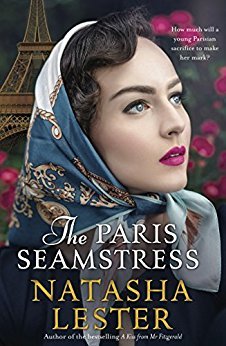
The Blurb (from Goodreads):
1940. Parisian seamstress Estella Bissette is forced to flee France as the Germans advance. She is bound for Manhattan with a few francs, one suitcase, her sewing machine, and a dream: to have her own atelier.
2015. Australian curator Fabienne Bissette journeys to the annual Met Gala for an exhibition of her beloved grandmother's work - one of the world's leading designers of ready-to-wear. But as Fabienne learns more about her grandmother's past, she uncovers a story of tragedy, heartbreak and secrets - and the sacrifices made for love.
Crossing generations, society's boundaries and international turmoil, The Paris Seamstress is the beguiling, transporting story of the special relationship between a grandmother and her granddaughter as they attempt to heal the heartache of the past.
My Thoughts:
A dual-timeline novel that moves between the 1940s and contemporary times, The Paris Seamstress is a gorgeously rich and romantic novel about young women finding their way in the world.
The story begins with Estella Bissette, a young apprentice seamstress working with her mother at a fashion designer’s atelier in Paris. Her metier is creating silk flowers, but she dreams of designing her own dresses and takes every opportunity to practise her craft. But the Nazis are closing on France, and no-one knows what the future will hold. One day Estella gets caught up in a mysterious errand that smacks of intrigue and resistance … and meets a handsome stranger. With her life in danger, she must flee France, and with her mother’s help, gets a bunk on the SS Washington - the last American ship to leave French waters – with nothing more than a suitcase and a sewing machine.
The other narrative thread concerns Estelle’s granddaughter Fabienne, who arrives in Manhattan from Sydney for a celebration of her famous ancestor’s fashion designs. Fabienne is puzzled by some mystery in her grandmother’s past which the recent death of her father has revealed to her, and wishes to question her … but Estella is elderly and frail, and talk of the past upsets her. At the gala event, Fabienne meets a handsome stranger … but her own life is full of problems and troubles, and it seems unlikely their paths will ever cross again.
From that point onwards, the two stories cross and part and cross again, full of sensual descriptions of fabulous clothes and evocative descriptions of Paris and New York, then and now. I loved the story of how determined Estella builds her career from nothing, despite obstacle after obstacle, and I empathised with sensitive Fabienne, trying to step out from her grandmother’ shadow.
Much of the pleasure of this book is the wish-fulfillment fantasy it offers many women – the chance to imagine oneself in a swishy satin gown, drinking cocktails with high society in New York, flitting off to Paris on a whim and meeting the man of your dreams, inheriting palatial residences in two of the city’s most glamorous and sophisticated cities, making a name for oneself with your talent and hard work. The secret at the heart of the novel is not one of those surprising, oh-my-god-I-never-saw-that-coming plot twists that leaves you gasping – it’s more of a device to put the two women’s journeys into motion. But both of those journeys are so beguiling, I didn’t mind that at all.
And I just loved Estella’s final words to her granddaughter:
‘Be brave. Love well and fiercely. Be the woman I always knew you would be.’
These are wise and beautiful words indeed.
You might also like to read my review of The French Photographer by Natasha Lester:

